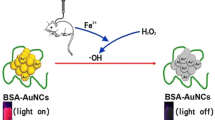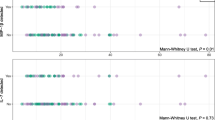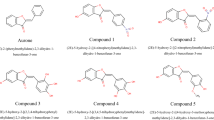Abstract
It is well known that misfolded peptides/proteins can play a role in processes of normal ageing and in the pathogenesis of many diseases including Alzheimer’s disease. Previously, we evaluated samples of cerebrospinal fluid from patients with Alzheimer’s disease and multiple sclerosis by means of thioflavin-T-based fluorescence. We observed attenuated effects of magnetite nanoparticles operated via anti-aggregation actions on peptides/proteins from patients with Alzheimer’s disease but not from those with multiple sclerosis when compared to age-related controls. In this study, we have evaluated the in vitro effects of anti-aggregation operating ferrofluid and phytoalexin spirobrassinin in the cerebrospinal fluid of patients with multiple sclerosis and Alzheimer’s disease. We have found significant differences in native fluorescence (λ excitation = 440 nm, λ emission = 485 nm) of samples among particular groups (young controls < multiple sclerosis, Alzheimer’s disease < old controls). Differences among groups were observed also in thioflavin-T-based fluorescence (young controls = multiple sclerosis < Alzheimer’s disease < old controls) and the most marked change from native to thioflavin-T-based fluorescence was found in young controls (28–40 years old people). Both ferrofluid and spirobrassinin evoked drops in thioflavin-T-based fluorescence; however, ferrofluid was more efficient in old controls (54–75 years old people) and spirobrassinin in multiple sclerosis patients, both compared to young controls. The results are discussed especially in relation to aggregated peptides/proteins and liposoluble fluorescent products of lipid peroxidation. Based on the significant effect of spirobrassinin in vitro, we suggest that spirobrassinin may be of therapeutic value in multiple sclerosis.


Similar content being viewed by others
References
Teunissen CE, Dijkstra C, Polman C (2005) Biological markers in CSF and blood for axonal degeneration in multiple sclerosis. Lancet Neurol 4:32–41
Wiltfang J, Lewczuk P, Riederer P, Grünblatt E, Hock C, Scheltens P, Hampel H, Vanderstichele H, Iqbal K, Galasko D, Lannfelt L, Otto M, Esselmann H, Henkel AW, Kornhuber J, Blennow K (2005) Consensus paper of the WFSBP task force on biological markers of dementia: the role of CSF and blood analysis in the early and differential diagnosis of dementia. World J Biol Psychiatry 6:69–84
Deisenhammer F, Egg R, Giovannoni G, Hemmer B, Petzold A, Sellebjerg F, Teunissen C, Tuman H (2009) EFNS guidelines on disease-specific CSF investigations. Eur J Neurol 16:760–770
Kristofikova Z, Bockova M, Hegnerova K, Bartos A, Klaschka J, Ricny J, Ripova D, Homola J (2009) Enhanced levels of mitochondrial enzyme 17β-hydroxysteroid dehydrogenase type 10 in patients with Alzheimer disease and multiple sclerosis. Mol BioSyst 5:1174–1179
Gazova Z, Antosova A, Kristofikova Z, Bartos A, Ricny J, Cechova L, Klaschka J, Ripova D (2010) Attenuated antiaggregation effects of magnetite nanoparticles in cerebrospinal fluid of people with Alzheimer’s disease. Mol BioSyst 6:2200–2205
Gilgun-Sherki Y, Melamed E, Offen D (2004) The role of oxidative stress in the pathogenesis of multiple sclerosis: the need for effective antioxidant therapy. J Neurol 251:261–268
Squier TC (2001) Oxidative stress and protein aggregation during biological aging. Exp Gerontol 36:1539–1550
Calabrese V, Raffaele R, Cosentino E, Rizza V (1994) Changes in cerebrospinal fluid levels of malondialdehyde and glutathione reductase activity in multiple sclerosis. Int J Clin Pharm Res 14:119–123
Calabrese V, Bella R, Testa D, Spadaro F, Scofani A, Rizza V, Pennisi G (1998) Increased cerebrospinal fluid and plasma levels of ultraweak chemiluminiscence are associated with changes in the thiol pool and lipid-soluble fluorescence in multiple sclerosis: the pathogenic role of oxidative stress. Drugs Exp Clin Res 24:125–131
Antosova A, Siposova K, Koneracka M, Zavisova V, Daxnerova Z, Vavra I, Fedunova D, Bagelova J, Kopcansky P, Gazova Z (2010) Magnetic fluid—a novel approach to treat amyloid-related diseases. Phys Procedia 9:262–265
Siposova K, Kubovcikova M, Bednarikova Z, Koneracka M, Zavisova V, Antosova A, Kopcansky P, Daxnerova Z, Gazova Z (2012) Depolymerization of insulin amyloid fibrils by albumin-modified magnetic fluid. Nanotechnology 23:055101
Anekonda TS (2006) Resveratrol—a boon for treating Alzheimer’s disease? Brain Res Rev 52:316–326
Martín AM, Villegas I, Sánchez-Hidalgo M, de la Lastra CA (2006) The effect of resveratrol, a phytoalexin derived from red wines, on chronic inflammation induced in an experimentally induced colitis model. Br J Pharmacol 147:873–885
Pedras MSC, Sarwar MG, Suchy M, Adio AM (2006) The phytoalexins from cauliflower, caulilexins A, B and C: isolation, structure determination, synthesis and antifungal activity. Phytochemistry 67:1503–1509
Mezencev R, Galizzi M, Kurschy P, Docampo R (2009) Trypanosoma cruzi: antiproliferative effect of indole phytoalexins on intracellular amastigotes in vitro. Exp Parasitol 122:66–69
Jin Z (2009) Muscarine, imidazole, oxazole and thiazole alkaloids. Nat Prod Rep 26:382–445
Gazova Z, Siposova K, Kurin E, Mucaji P, Nagy M (2013) Amyloid aggregation of lysozyme: the synergy study of red wine polyphenols. Proteins 81:994–1004
Frederikse PH, Garland D, Zigler JS, Piatigorsky J (1996) Oxidative stress increases production of β-amyloid precursor protein and β-amyloid (Aβ) in mammalian lenses, and Aβ has toxic effects on lens epithelial cells. J Biol Chem 271:10169–10174
McDonald WI, Compston A, Edan G, Goodkin D, Hartung HP, Lublin FD, McFarland HF, Paty DW, Polman CH, Reingold SC, Sandberg-Wollheim M, Sibley W, Thompson A, van den Noort S, Weinshenker BY, Wolinsky JS (2001) Recommended diagnostic criteria for multiple sclerosis: guidelines from the international panel on the diagnosis of multiple sclerosis. Ann Neurol 50:121–127
McKhann GM, Knopman DS, Chertkow H, Hyman BT, Jack CR, Kawas CH, Klunk WE, Koroshetz WJ, Manly JJ, Mayeux R, Mohs RC, Morris JC, Rossor MN, Scheltens P, Carillo MC, Thies B, Weintraub S, Phelps CH (2011) The diagnosis of dementia due to Alzheimer’s disease: recommendations from the National Institute on Aging-Alzheimer’s Association workgroups on diagnostic guidelines for Alzheimer’s disease. Alzheimers Dement 7:263–269
Massart OR (1981) Preparation of aqueous magnetic fluids in alkaline and acidic media. IEEE Trans Magn 17:1247–1248
Bergquist J, Gilman SD, Ewing AG, Ekman R (1994) Analysis of human cerebrospinal fluid by capillary electrophoresis with laser-induced fluorescence detection. Anal Chem 66:3512–3518
Park YH, Zhang X, Rubakhin S, Sweedler JW (1999) Independent optimization of capillary electrophoresis separation and native fluorescence detection conditions for indolamine and catecholamine measurements. Anal Chem 71:4997–5002
Ostachowicz B, Boruchowska M, Lankosz M, Tomik B, Szczudlik A, Adamek D (2004) Application of the TXRF method to the elemental analysis of cerebrospinal fluid in amyotrophic lateral sclerosis. X-Ray Spectrom 33:46–49
Zheng W, Li D, Zeng Y, Luo Y, Qu JY (2010) Two-photon excited hemoglobin fluorescence. Biomed Opt Express 2:71–79
Meir S, Philosoph-Hadas S, Aharoni N (1992) Ethylene-increased accumulation of fluorescent lipid-peroxidation products detected during senescence of parsley by a newly developed method. J Am Soc Hortic Sci 117:128–132
Patkova J, Vojtisek M, Tuma J, Vozeh F, Knotkova J, Santorova P, Wilhelm J (2012) Evaluation of lipofuscin-like pigments as an index of lead-induced oxidative damage in the brain. Exp Toxicol Pathol 64:51–56
Lindgren M, Sörgjerd K, Hammarström P (2005) Detection and characterization of aggregates, profibrillar amyloidogenic oligomers, and protofibrils using fluorescence spectroscopy. Biophys J 88:4200–4212
Maezawa I, Hong HS, Liu R, Wu CY, Cheng RH, Kung MP, Kung HF, Lam KS, Oddo S, LaFerla FM, Jin LW (2008) Congo red and thioflavin/T analogs detect Aβ oligomers. J Neurochem 104:457–468
Hawe A, Sutter M, Jiskoot W (2008) Extrinsic fluorescent dyes as tools for protein characterization. Pharm Res 25:1487–1499
Groenning M (2010) Binding mode of Thioflavin T and other molecular probes in the context of amyloid fibrils—current status. J Chem Biol 3:1–18
Oliveira SR, Kallaur AP, Simão AN, Morimoto HK, Lopes J, Panis C, Petenucci DL, da Silva E, Cecchini R, Kaimen-Maciel DR, Reiche EM (2012) Oxidative stress in multiple sclerosis patients in clinical remission: association with the expanded disability status scale. J Neurol Sci 321:49–53
Arlt S, Müller-Thomsen T, Beisiegel U, Kontush A (2012) Effect of one-year vitamin C- and E-supplementation on cerebrospinal fluid oxidation parameters and clinical course in Alzheimer’s disease. Neurochem Res 37:2706–2714
Acknowledgments
In Slovakia, the study was supported within the projects Nos. 26220120021, 26220220005 in frame of Structural Funds of European Union, VEGA 0181 and projects of the Slovak Research and Development Agency, contract nos. APVV-0171-10 and SK-RO-0016-12. In the Czech Republic, the study was supported by IGA NT 13183, GACR P304/12/G069 and MH CZ-DRO (PCP, 00023752) project. The authors thank M. Koneracka and V. Zavisova for preparing the ferrofluid and P. Kutschy for synthesis of and providing the spirobrassinin.
Author information
Authors and Affiliations
Corresponding author
Rights and permissions
About this article
Cite this article
Kristofikova, Z., Gazova, Z., Siposova, K. et al. Effects of Ferrofluid and Phytoalexin Spirobrassinin on Thioflavin-T-Based Fluorescence in Cerebrospinal Fluid of the Elderly and Multiple Sclerosis Patients. Neurochem Res 39, 1502–1510 (2014). https://doi.org/10.1007/s11064-014-1340-0
Received:
Revised:
Accepted:
Published:
Issue Date:
DOI: https://doi.org/10.1007/s11064-014-1340-0




